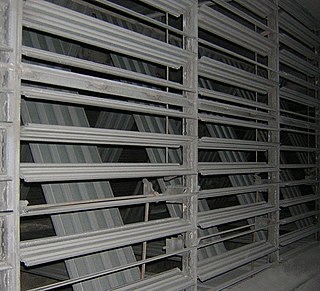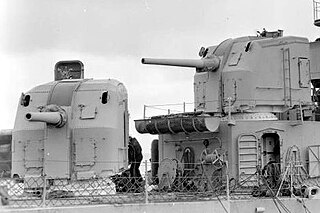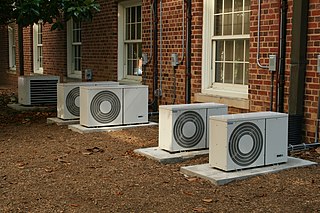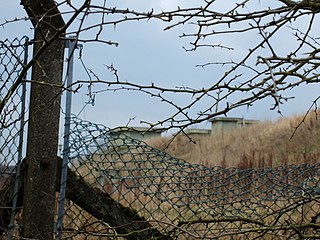External links
- Control Room Presents on IMDb
- Control Room Presents at The Futon Critic
| This article about a music television show originating in the United States is a stub. You can help Wikipedia by expanding it. |
Control Room Presents is a series which aired on MyNetworkTV in the United States from October 1, 2007 to March 15, 2008.
The program aired previously recorded music concerts from various popular artists.
| This article about a music television show originating in the United States is a stub. You can help Wikipedia by expanding it. |

Heating, ventilation, and air conditioning (HVAC) is the technology of indoor and vehicular environmental comfort. Its goal is to provide thermal comfort and acceptable indoor air quality. HVAC system design is a subdiscipline of mechanical engineering, based on the principles of thermodynamics, fluid mechanics and heat transfer. "Refrigeration" is sometimes added to the field's abbreviation, as HVAC&R or HVACR or "ventilation" is dropped, as in HACR.

A dehumidifier is an electrical appliance which reduces and maintains the level of humidity in the air, usually for health or comfort reasons, or to eliminate musty odor and to prevent the growth of mildew by extracting water from the air. It can be used for household, commercial, or industrial applications. Large dehumidifiers are used in commercial buildings such as indoor ice rinks and swimming pools, as well as manufacturing plants or storage warehouses.

A cleanroom or clean room is a facility ordinarily utilized as a part of specialized industrial production or scientific research, including the manufacture of pharmaceutical items, integrated circuits, CRT, LCD, OLED and microLED displays. Cleanrooms are designed to maintain extremely low levels of particulates, such as dust, airborne organisms, or vaporized particles. Cleanrooms typically have a cleanliness level quantified by the number of particles per cubic meter at a predetermined molecule measure. The ambient outdoor air in a typical urban area contains 35,000,000 particles for each cubic meter in the size range 0.5 μm and bigger in measurement, equivalent to an ISO 9 cleanroom, while by comparison an ISO 1 cleanroom permits no particles in that size range and just 12 particles for each cubic meter of 0.3 μm and smaller.

The Boeing E-4 Advanced Airborne Command Post (AACP), the current "Nightwatch" aircraft, is a strategic command and control military aircraft operated by the United States Air Force (USAF). The E-4 series are specially modified from the Boeing 747-200B for the National Emergency Airborne Command Post (NEACP) program. The E-4 serves as a survivable mobile command post for the National Command Authority, namely the President of the United States, the Secretary of Defense, and successors. The four E-4Bs are operated by the 1st Airborne Command and Control Squadron of the 595th Command and Control Group located at Offutt Air Force Base, near Omaha, Nebraska. An E-4B when in action is denoted a "National Airborne Operations Center".

Master control is the technical hub of a broadcast operation common among most over-the-air television stations and television networks. It is distinct from a production control room (PCR) in television studios where the activities such as switching from camera to camera are coordinated. It is also vastly different from the studio where the talent are located. A transmission control room (TCR) is usually smaller in size and is a scaled down version of centralcasting.

A television studio, also called a television production studio, is an installation room in which video productions take place, either for the recording of live television to video tape, or for the acquisition of raw footage for post-production. The design of a studio is similar to, and derived from, movie studios, with a few amendments for the special requirements of television production. A professional television studio generally has several rooms, which are kept separate for noise and practicality reasons. These rooms are connected via 'talkback' or an intercom, and personnel will be divided among these workplaces.

A damper is a valve or plate that stops or regulates the flow of air inside a duct, chimney, VAV box, air handler, or other air-handling equipment. A damper may be used to cut off central air conditioning to an unused room, or to regulate it for room-by-room temperature and climate control. Its operation can be manual or automatic. Manual dampers are turned by a handle on the outside of a duct. Automatic dampers are used to regulate airflow constantly and are operated by electric or pneumatic motors, in turn controlled by a thermostat or building automation system. Automatic or motorized dampers may also be controlled by a solenoid, and the degree of air-flow calibrated, perhaps according to signals from the thermostat going to the actuator of the damper in order to modulate the flow of air-conditioned air in order to effect climate control.

Building automation is the automatic centralized control of a building's heating, ventilation and air conditioning, lighting and other systems through a building management system or building automation system (BAS). The objectives of building automation are improved occupant comfort, efficient operation of building systems, reduction in energy consumption and operating costs, and improved life cycle of utilities.

The National Military Command Center (NMCC) is a Pentagon command and communications center for the National Command Authority. Maintained by the Department of the Air Force as the "DoD Executive Agent" for NMCC logistical, budgetary, facility and systems support; the NMCC operators are in the Joint Staff's J-3 (Operations) Directorate. "The NMCC is responsible for generating Emergency Action Messages (EAMs) to missile launch control centers, nuclear submarines, recon aircraft and battlefield commanders".

A fan heater, also called a blow heater, is a heater that works by using a fan to pass air over a heat source. This heats up the air, which then leaves the heater, warming up the surrounding room. They can heat an enclosed space such as a room faster than a heater without fan, but, like any fan, create audible noise.

The Mark 12 5"/38 caliber gun was a United States naval gun. The gun was installed into Single Purpose and Dual Purpose mounts used primarily by the US Navy. On these 5" mounts, Single Purpose (SP) means that the mount is limited to 35° elevation with no provision for AA shell fuze setters, and is designed to fire at surface targets only. Dual Purpose (DP) means that it is designed to be effective against both surface and aircraft targets because it can elevate to 85° and has on mount AA shell fuze setters. The 38 caliber barrel was a mid-length compromise between the previous United States standard 5"/51 low-angle gun and 5"/25 anti-aircraft gun. United States naval gun terminology indicates the gun fired a projectile 5 inches (127 mm) in diameter, and the barrel was 38 calibers long, making the 5"/38 dual purpose midway in barrel length between the 5"/51 surface-to-surface and the 5"/25 anti-aircraft guns. The increased barrel length provided greatly improved performance in both anti-aircraft and anti-surface roles compared to the 5"/25 gun. However, except for the barrel length and the use of semi-fixed ammunition, the 5"/38 gun was derived from the 5"/25 gun. Both weapons had power ramming, which enabled rapid fire at high angles against aircraft. The 5"/38 entered service on USS Farragut, commissioned in 1934. The base ring mount, which improved the effective rate of fire, entered service on USS Gridley, commissioned in 1937.

A mechanical room or a boiler room is a room or space in a building dedicated to the mechanical equipment and its associated electrical equipment, as opposed to rooms intended for human occupancy or storage. Unless a building is served by a centralized heating plant, the size of the mechanical room is usually proportional to the size of the building. A small building or home may have at most a utility room but in large buildings mechanical rooms can be of considerable size, often requiring multiple rooms throughout the building, or even occupying one or more complete floors.

Air conditioning is the process of removing heat and moisture from the interior of an occupied space to improve the comfort of occupants. Air conditioning can be used in both domestic and commercial environments. This process is most commonly used to achieve a more comfortable interior environment, typically for humans and other animals; however, air conditioning is also used to cool and dehumidify rooms filled with heat-producing electronic devices, such as computer servers, power amplifiers, and to display and store some delicate products, such as artwork.
Characterizing how air is introduced to, flows through, and is removed from spaces is called room air distribution. HVAC airflow in spaces generally can be classified by two different types: mixing and displacement.

Royal Air Force Barton Hall or more simply RAF Barton Hall is a former Royal Air Force station situated between the villages of Barton and Broughton, near Preston, Lancashire, England.

A fan coil unit (FCU), also known as a Vertical Fan Coil-Unit (VFC), is a simple device consisting of a heating and/or cooling heat exchanger or 'coil' and fan. It is part of an HVAC system found in residential, commercial, and industrial buildings. A fan coil unit is a diverse device sometimes using ductwork, and is used to control the temperature in the space where it is installed, or serve multiple spaces. It is controlled either by a manual on/off switch or by a thermostat, which controls the throughput of water to the heat exchanger using a control valve and/or the fan speed.

NASA's Christopher C. Kraft Jr. Mission Control Center, also known by its radio callsign, Houston, is the facility at the Lyndon B. Johnson Space Center in Houston, Texas, that manages flight control for America's human space program, currently involving astronauts aboard the International Space Station (ISS). The center is in Building 30 at the Johnson Space Center which is named after Christopher C. Kraft Jr., a NASA engineer and manager who was instrumental in establishing the agency's Mission Control operation, and was the first Flight Director.
Engineering controls are strategies designed to protect workers from hazardous conditions by placing a barrier between the worker and the hazard or by removing a hazardous substance through air ventilation. Engineering controls involve a physical change to the workplace itself, rather than relying on workers' behavior or requiring workers to wear protective clothing.

Gran Hermano VIP is a reality television series broadcast in Spain on Telecinco produced by Endemol. It is the celebrity version of Gran Hermano and part of the Big Brother franchise first developed in the Netherlands. The first edition of the program was broadcast in 2004. As of September 2019, 7 editions of the show have aired.